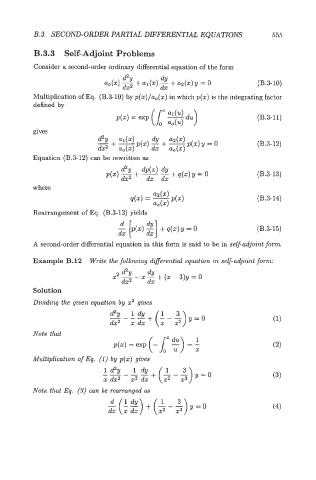Page 575 - Modelling in Transport Phenomena A Conceptual Approach
P. 575
B.3. SECOND-ORDER PARTIAL DIFFER.ENTM EQUATIONS 555
B.3.3 Self-Adjoint Problems
Consider a second-order ordinary differential equation of the form
(B.3-10)
Multiplication of Eq. (B.3-10) by p(x)/ao(x) in which p(x) is the integrating factor
defined by
(B .3- 11)
gives
+
8Y a1(x) dY a2(x)
- -p(x) - + ----P(X)Y = 0 (B.3-12)
dx2 ao(x) dx a,(x)
Equation (B.3-12) can be rewritten its
(B.3-13)
where
(B.3-14)
Rearrangement of Eq. (B.3-13) yields
(B.3- 15)
A second-order differential equation in this form is said to be in self-adjoint form.
Example B. 12 Write the following differential equation in self-adjoint form:
dY
x 28Y --X-+(X-~)Y=~
dx2 dx
Solution
Dividing the given equation by x2 gives
Note that
Multiplication of Eq. (1) by p(x) gives
Note that Eq. (3) can be recarranged as
- (- -) + ($ - $) Y = 0
d
1
dy
dx x dx (4)

